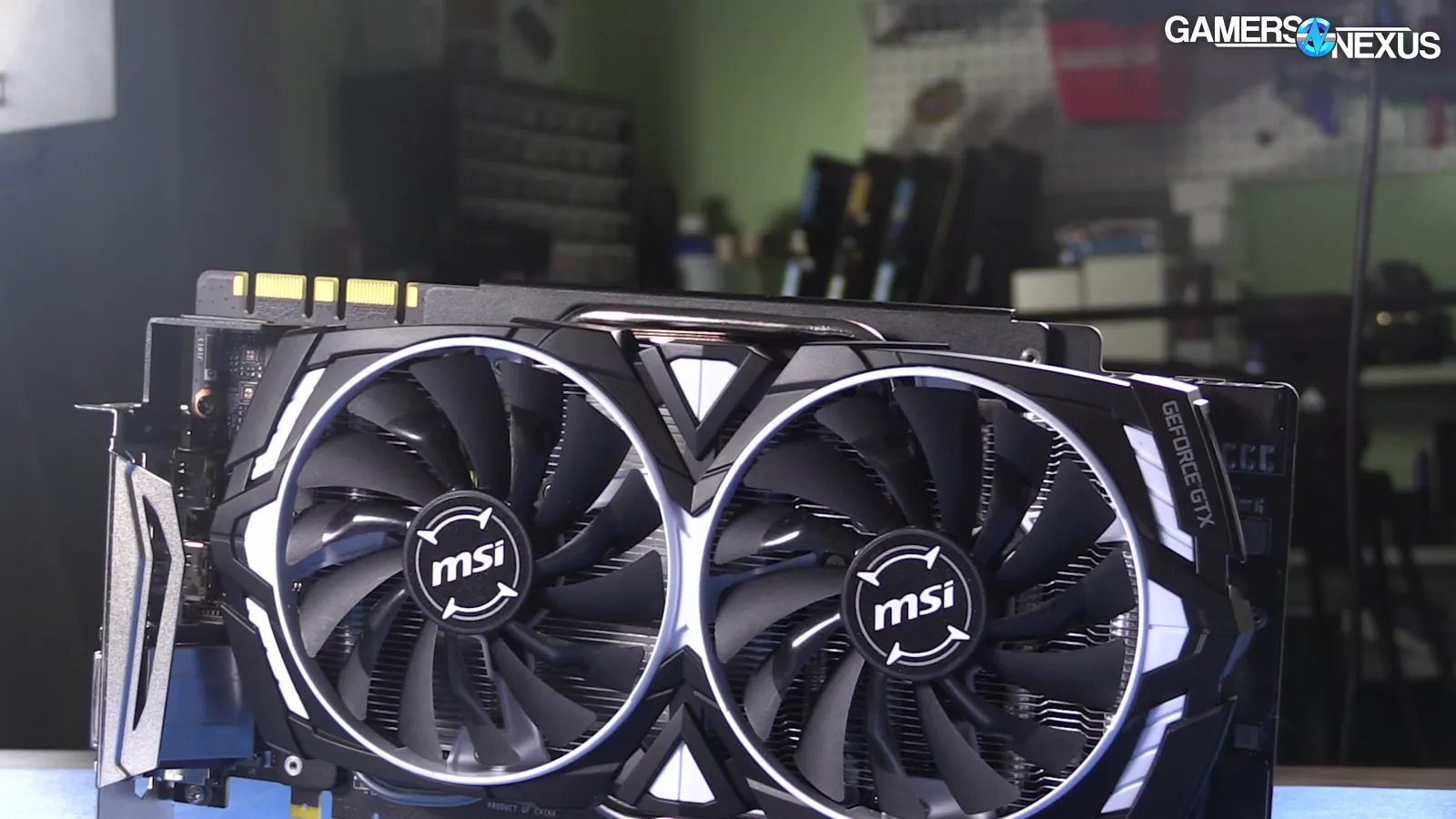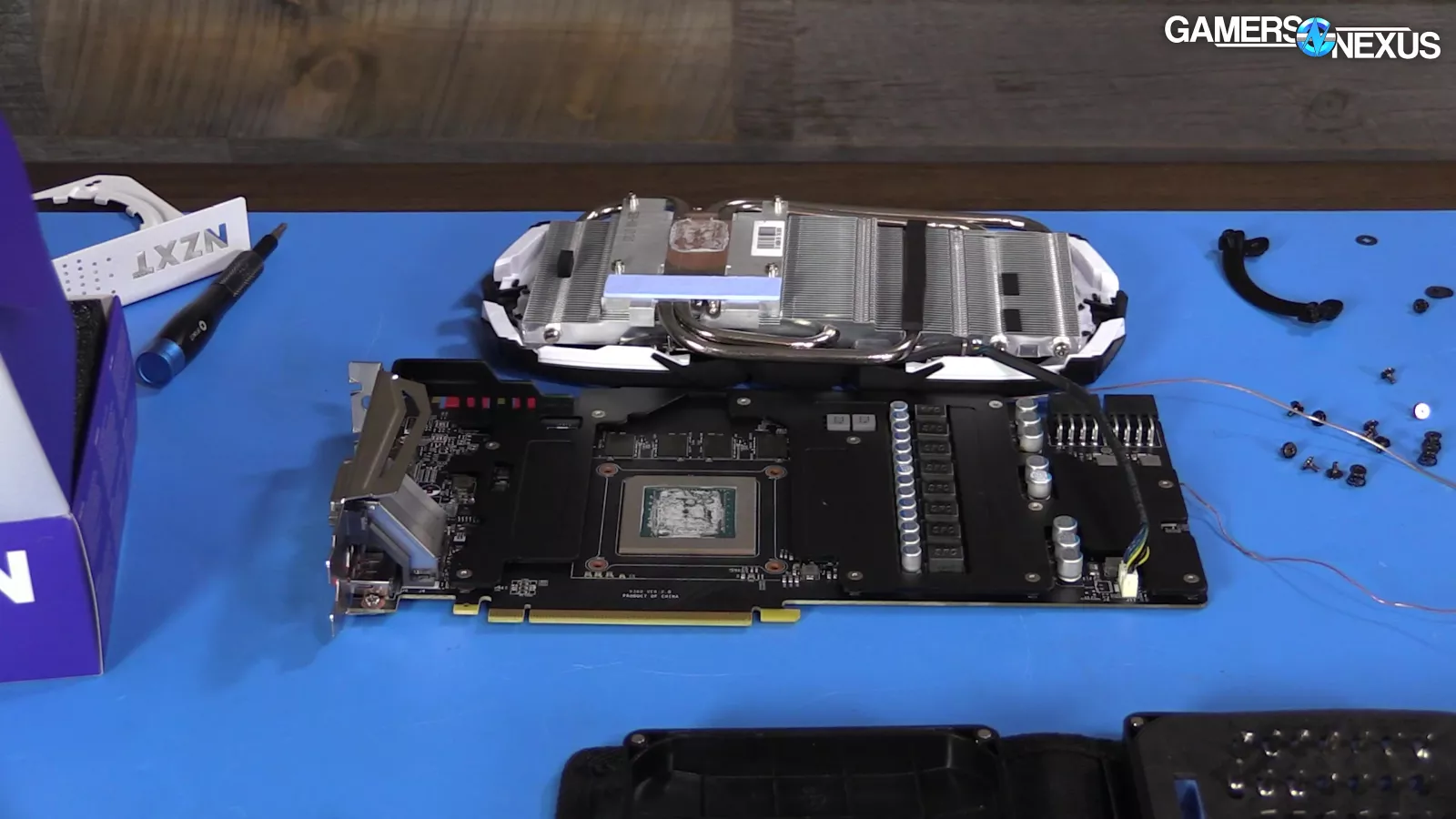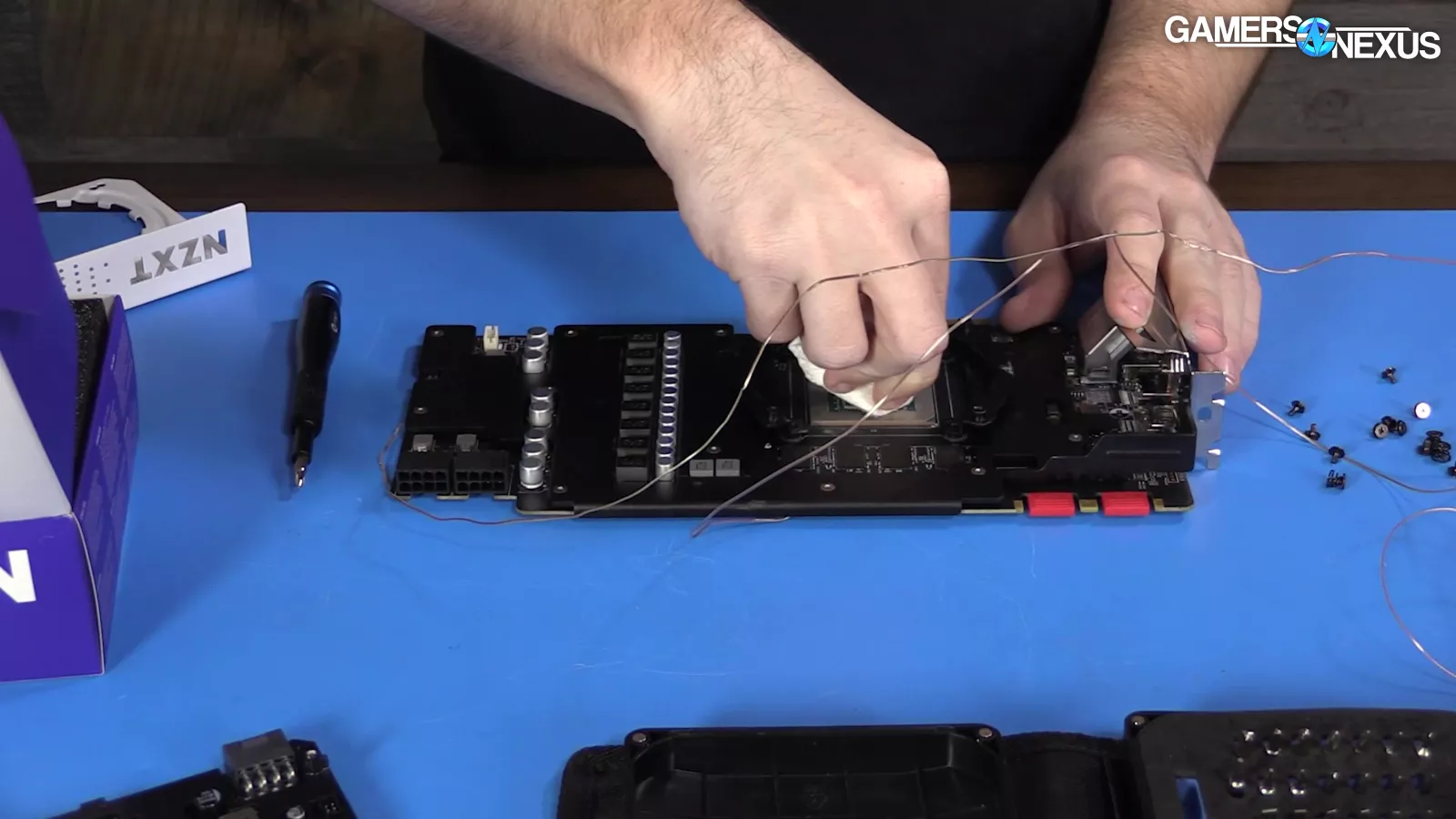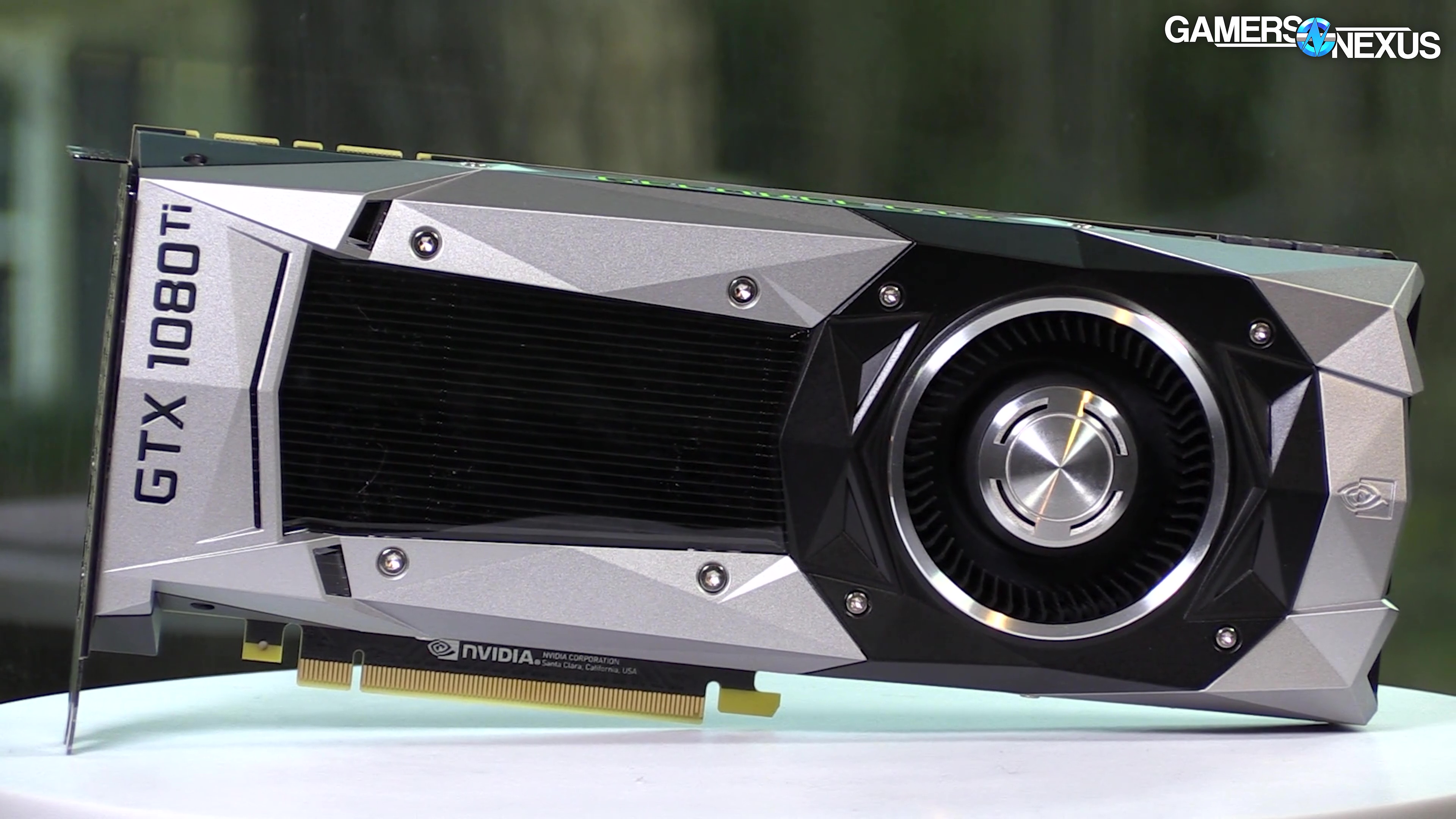
The Greatest GPU of All Time: NVIDIA GTX 1080 Ti & GTX 1080 2024 Revisit & History
Last Updated:
We revisit the GTX 1080 Ti with modern gaming benchmarks and examine sensible upgrade options
The Highlights
- The GTX 1080 Ti offered exceptional performance and value for its time
- The 1080 Ti is held back today by not being able to handle ray tracing
- The 1080 Ti is the GOAT GPU that still holds up in many gaming scenarios 7 years after its launch
- Original MSRP: $700
- Release Date: March 10, 2017
Table of Contents
- AutoTOC

Intro
Today, we’re revisiting the GTX 1080 (watch our original review here) and the best card NVIDIA ever made: The GTX 1080 Ti (watch our original review here).
This card is the GOAT. No questions about it. Steve actually still uses it at his house in his personal machine. Specifically, he uses an EVGA GTX 1080 Ti SC2 ICX card (watch our review here), which he really liked for the performance and overall size.
It’s so good that we’ve revisited it now at least 2 or 3 times, and this time, it’s with all the modern cards on the charts. We also added some new charts to this revisit to help get up to speed quickly.
Editor's note: This was originally published on April 6, 2024 as a video. This content has been adapted to written format for this article and is unchanged from the original publication.
Credits
Host, Writing
Steve Burke
Testing
Patrick Lathan
Testing, Video Editing
Michael Gaglione
Camera, Video Editing
Vitalii Makhnovets
Tim Phetdara
Writing, Web Editing
Jimmy Thang
For many years now, and with each revisit, we have said that the GTX 1080 Ti is a mistake that NVIDIA will never make again. Its MSRP was only $100 above the GTX 1080, or maybe $200 depending on how you counted the mess of FE models and partner models of that era. But even at the higher end of that, it was a relatively small price jump for a significant performance improvement. It was the 4090 of the era.
When the RTX 20 series launched, it only made the 1080 Ti look even better.
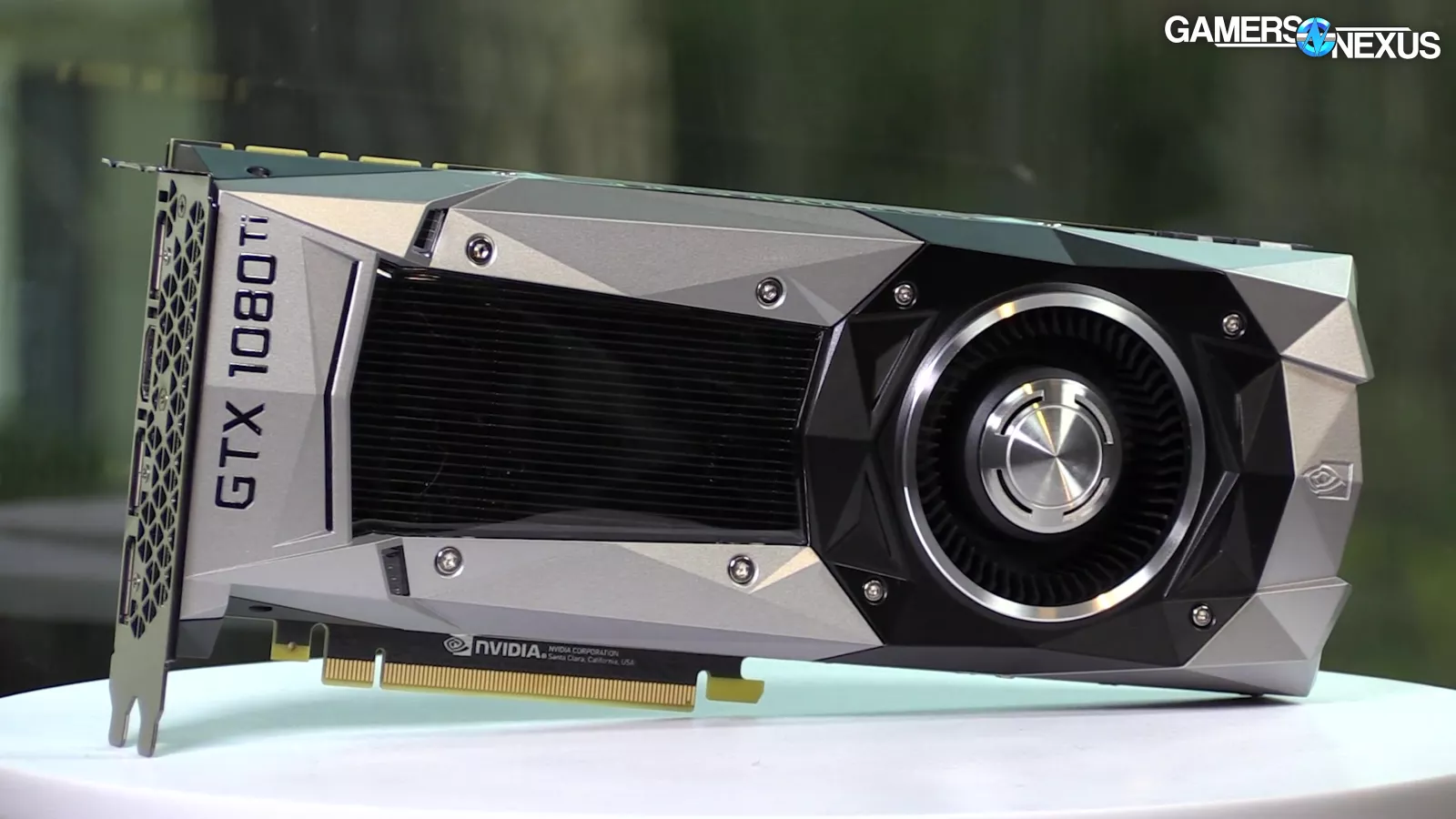
The 20 launch really is what cemented the 1080 Ti in its place. With the launch of the RTX 2080 (watch our review here), we told everyone to just buy a 1080 Ti instead. That’s because they could still be had for -- believe it or not -- around $700 in many cases.
The MSI Armor series was a barebones, trash-tier cooler that made for a dirt cheap entry to the 1080 Ti that could be converted into a hybrid or liquid cooled card to create a monster. The SC series also competed strongly here. And at that price, it was commonly $100 under the new 2080s while offering equivalent or sometimes better performance. The namesake feature of the 2080, “RTX,” had 0 games at launch and would not for a long while after. While RT is relevant today, there was no telling how long that market would take to shape-up at the time.
The 1080 Ti immediately gained legendary status with that launch. Now, 7 years later, it can still handle a lot of the games in our testing at reasonable FPS. Its biggest weakness is a lack of support for modern features like RT hardware. If you’re OK without it, depending on the games you’re playing, it may remain good until the next generation.
The GTX 1080 Ti launched in March of 2017, about a year after the 1080’s launch in 2016. It was a powerful one-two punch from NVIDIA. At the time, its newest competition from AMD would have been the RX 580 (watch our review here) that launched in April of 2017, which itself was a refresh of the RX 480 (watch our review here). Otherwise, the 1080 Ti was up against an aging generation of Fury cards. Vega wouldn’t come out for another several months, and largely to disappointing reception.
This was also in an era when AMD was absolutely plagued and riddled with driver problems. If the AMD drivers had a door, opening them was like walking into a dark room filled with roaches. They’d scatter.
AMD’s drivers have grown substantially since then and improved in huge ways. AMD is past the worst of its driver woes, but back then, it was bleak for AMD’s offerings. They chose to fight more in the mid-range market. The RX 580 was a well-positioned card, and one for which we unfortunately have no modern like-for-like replacement at the price.
Looking back, that was an era we all probably took for granted. The 1080 Ti made for amazing performance at the high-end and the RX 580 made for a powerful card at the $200-$250 mark. The whole market was covered pretty well.
GTX 1080 Ti Price Adjusted for Inflation
Let’s do a quick look at the pricing and adjust for inflation.
GTX 1080 Ti & 1080 Prices & Inflation (2024)
| Common Price of Era | Inflation-Adjusted | |
| GTX 1080 Ti | $700 to $800 | $880.73 to $1,006.55 |
| GTX 1080 | $600 to $700 | $766 to $894 |
The GTX 1080 Ti was often $700, like the MSI Armor card, and ran up to $800. There were more expensive cards as always, but these two price points covered the vast majority of options.
Today, a $700 purchase of the 1080 Ti would be equivalent to spending $880.73, according to US inflation data. An $800 purchase would be equivalent to $1,006.55. If you look at GPUs available right now, that $880 adjusted price would be an RTX 4070 Ti Super from NVIDIA or an RX 7900 XTX from AMD, flanking each end. The $1,000 inflation-adjusted 1080 Ti price would be an RTX 4080 Super’s MSRP, if you can find one at MSRP, or again, a 7900 XTX.
Back to the inflation table, the GTX 1080 was $600 to $700 commonly. And again, remember that NVIDIA made this all very messy with its FE pricing of the time. That’d be $766 to $894 today.
Equivalents would again include the 4070 Ti Super from NVIDIA and the RX 7900 XT to 7900 XTX (watch our review here) from AMD.
GTX 1080 Ti Used Pricing
What’s wild is the used price of the GTX 1080 Ti. In a quick look around, they seem to commonly be selling for $150 to $200, or sometimes cheaper if you buy one with a broken fan. That’d be easy to fix.
That makes a used GTX 1080 Ti a better option than NVIDIA’s modern $150 to $200 cards -- or sometimes even its $300 card. NVIDIA’s own masterpiece remains a thorn in its side for new sales and for expectations.
The 3080 (watch our review here) did well to reset from the 20 series, but its limited availability at the strong launch price quickly evaporated its hopes of having a similar long-term reception as the 1080 Ti.
It’s time to get into some numbers.
GPU Reviews Test Bench
| Part | Component | Provided By |
| CPU | Intel Core i7-12700KF Overclocked (4.9GHz P-Cores, 3.9GHz E-Cores) | Bought by GN |
| Motherboard | MSI Z690 Unify | MSI |
| RAM | DDR5-6000 G.Skill Trident Z (manually tightened timings) | G.Skill |
| Cooler | Arctic Liquid Freezer II 360 @ 100% Fan Speed | Bought by GN |
| PSU | EVGA 1600W T2 Supernova Corsair AX1600i | EVGA Corsair |
| OS | Windows 11 | Bought by GN |
Summary: GTX 1080 vs. GTX 1080 Ti in 2024
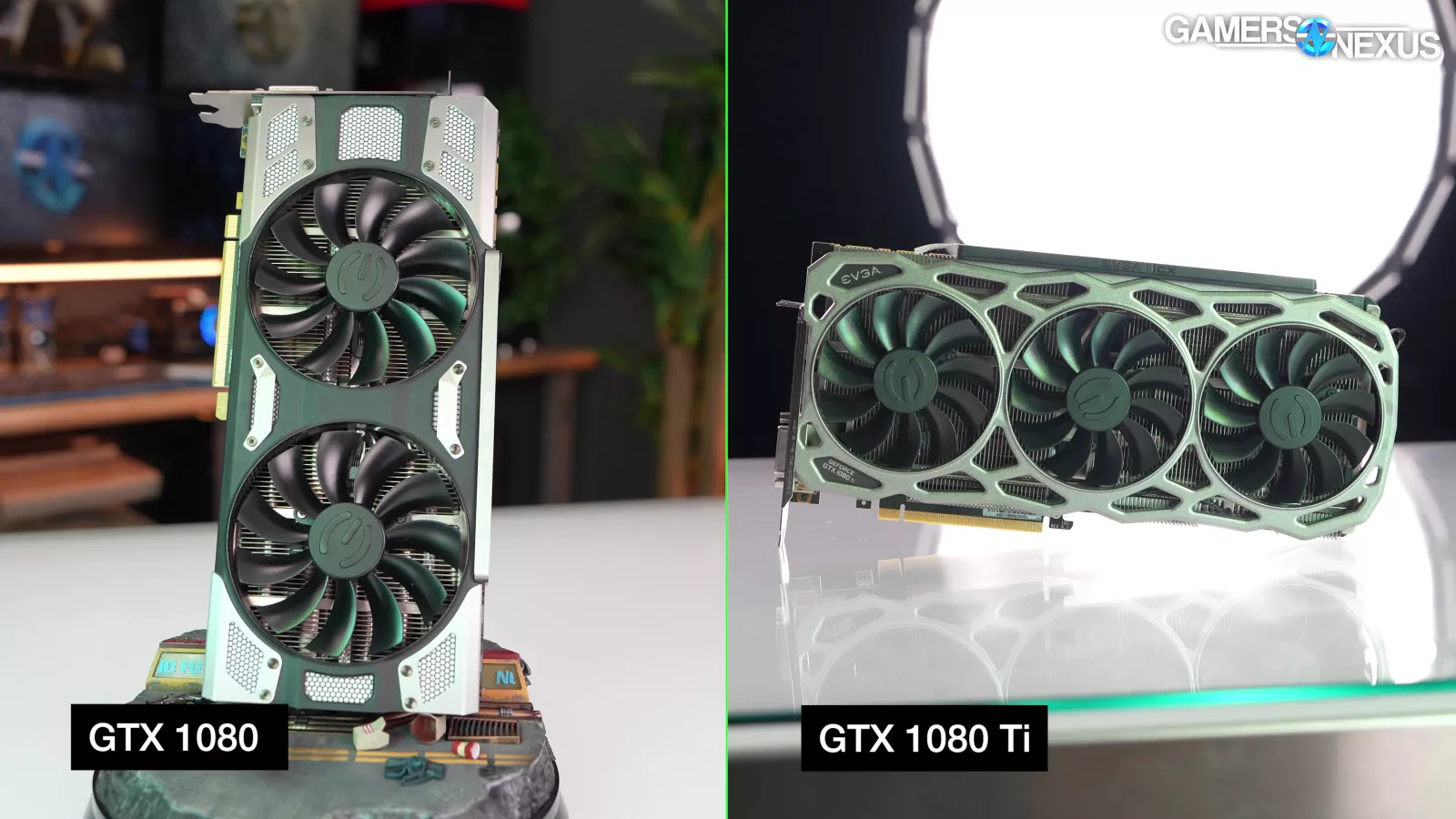
We’ll start with re-establishing our bearings for how the GTX 1080 and GTX 1080 Ti compare to each other today. This factors-in the latest drivers for each, Windows updates, and modernized changes to the BIOS and OS (such as ReBAR and hardware-accelerated GPU scheduling).
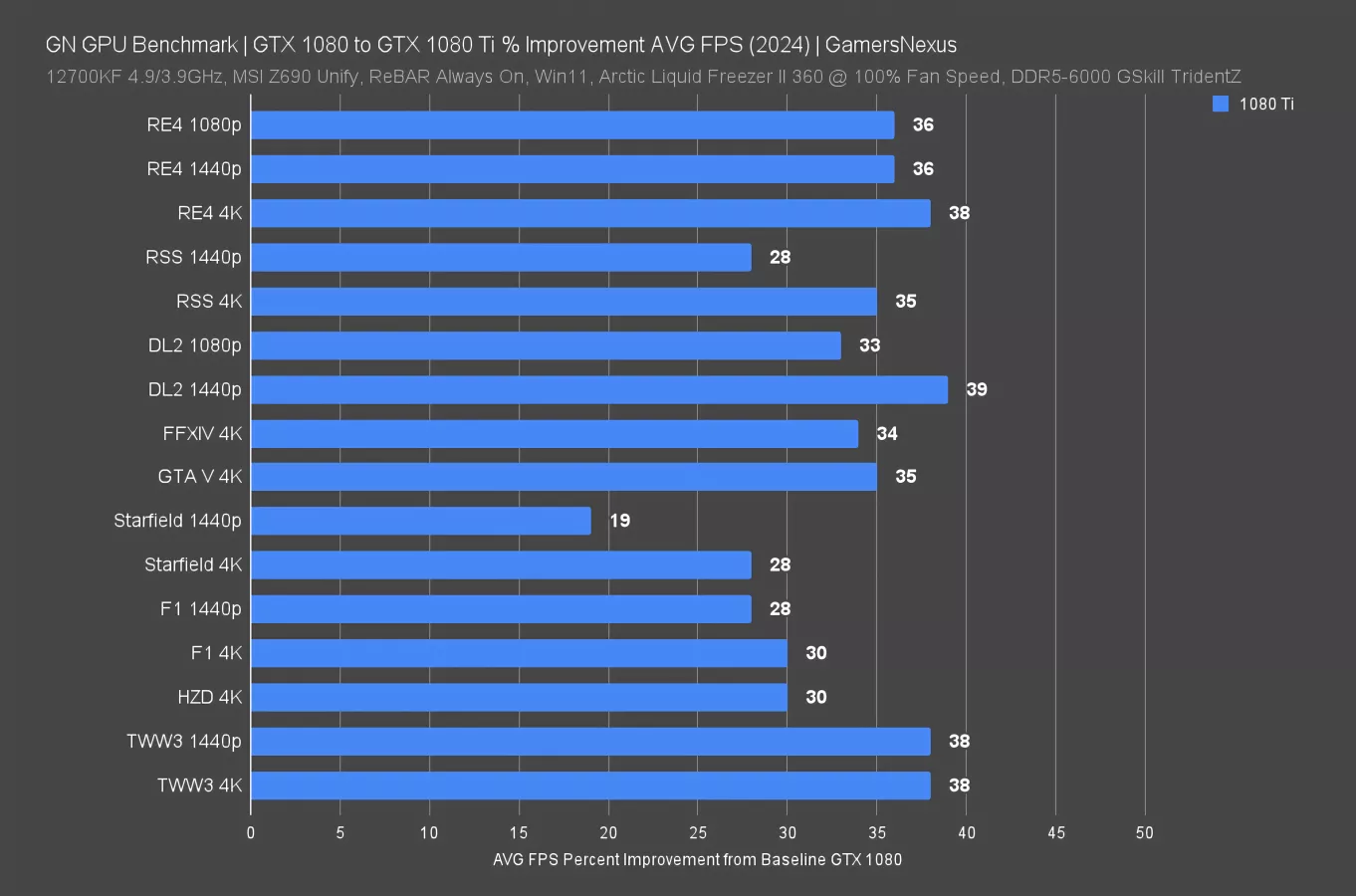
Here’s the chart. This shows the percent improvement from a GTX 1080 to a GTX 1080 Ti in various games we test in 2024. It’s remarkably consistent from game-to-game in this era, even across resolutions. That’s a big difference from what we see between the cards today, where NVIDIA plays with memory bandwidth in ways that create less predictable scaling across resolutions.
The GTX 1080 Ti is generally about 35% better than the GTX 1080 in AVG FPS for today’s benchmarks. If you had waited until the 1080 Ti launched and spent about $100 more, max around $200 more, then that money stretched pretty well and could have been a deciding factor in stretching the card out for one more generation.
As a side note, it’s rare that we see 38% uplift for $100 these days. That doesn’t really happen anymore, but the fact that NVIDIA priced the 1080 Ti at $100 to $200 above the GTX 1080 (broadly speaking) seems like it will never happen again with such consistency when looking at the performance improvement. It almost seems like a mistake.
Summary: Equal To Table
Since we’ve revisited the GTX 1080 Ti so much, we’re going to do something different this time. We’ll start with a new style of simple table that we haven’t used before: It recaps several games we’ve tested and shows the most immediate better and worse cards in any modern generation. The table also shows the closest equal of any generation. As usual, the disclaimer “of what we’ve tested recently” applies. There are other equals or flanks, but we’re looking at recent benchmarks.
The intended use of the table is to help you understand your baseline. If you know the most immediately better and worse cards, you can start to approximate where a 1080 Ti would fall on any chart (even if that chart lacks the 1080 Ti). Likewise, you can also figure out your baseline if you want to improve with an upgrade, not sidegrade to something similar.
Here it is.
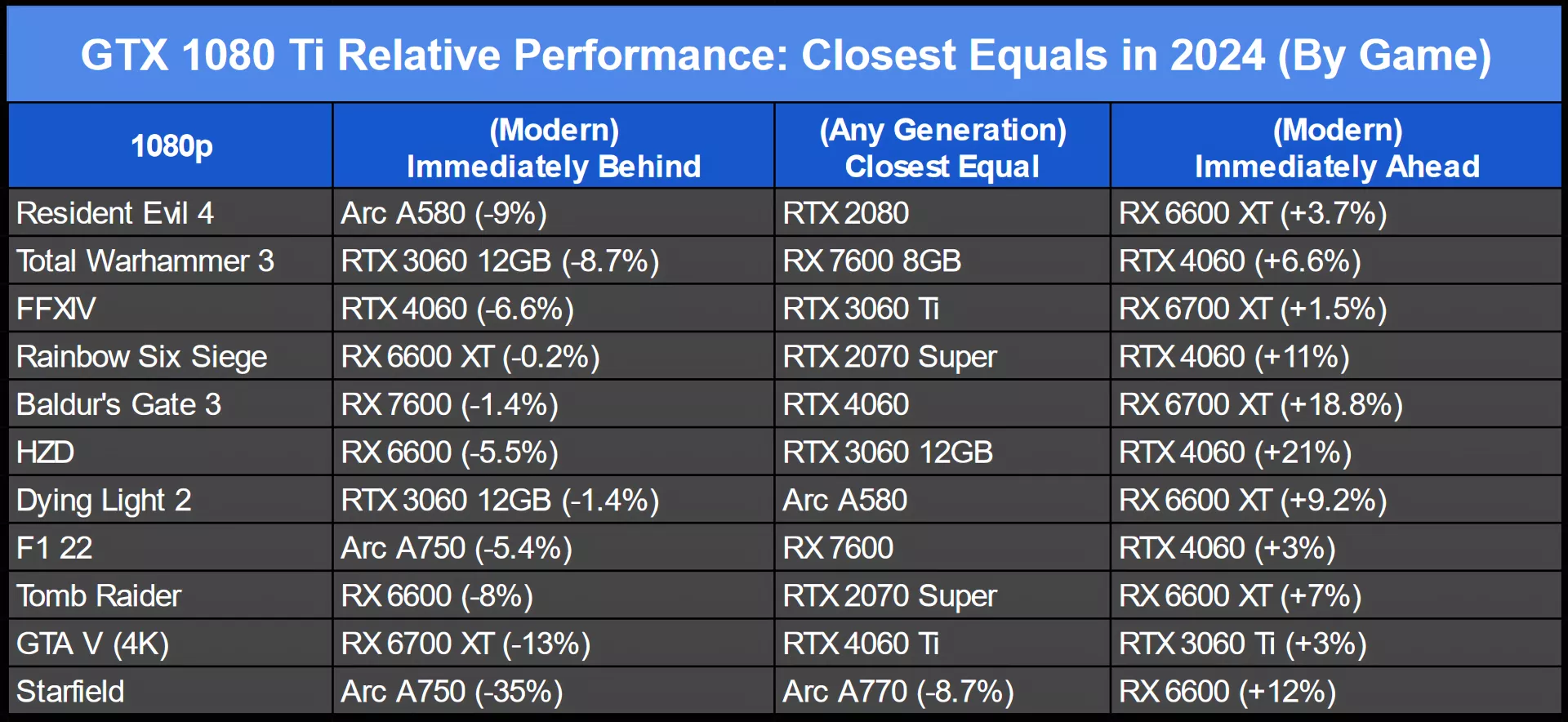
The most immediately behind, modern architecture GPU is generally the RX 6600, 6600 XT, or NVIDIA’s 60-class cards like the RTX 3060 (watch our review here) and 4060. Intel Arc also makes a few appearances. This tells you that if you wanted to upgrade, you need to buy at least better than these cards in the modern lineup to get any meaningful improvement at all -- and ideally, a couple steps up from them to ensure it is actually meaningful and not just a sidegrade with ray tracing capabilities.
The closest of any generation we’ve recently tested is variable. We see the 2070 Super (watch our review here) appear a few times and the RX 7600, but it really depends on the game tested. The RTX 2080 (watch our review here) also makes an appearance.
For the most immediately advantaged modern generation card, the 1080 Ti is commonly beaten most immediately by the same cards as were immediately behind it. This makes sense. When a card is +/- a few percentage points, it can swing either way. The 4060 appears the most here. If you’re not buying at least a 4070 or 6700 XT as a replacement, generally speaking, we don’t think it’d be worth buying a new card.
Recap: GTX 1080 Ti vs. 4070 Ti Super, 4080, 7900 XT, & 7900 XTX
Let’s look at this another way. Instead of the most immediate flanks, which can return largely similar results due to the nature of small changes, let’s look at the uplift offered by the most likely upgrade candidates. These are chosen assuming a buyer is hoping to get the most uplift but spend around the same money as they originally did. We think the most relevant by these standards would be the RTX 4070 Ti Super (read our review here) and RX 7900 XT, followed by the RTX 4080 Super and RX 7900 XTX for those who may want to spend more than they did years ago. This also helps you understand what spending another $150-$300 will get you for uplift.
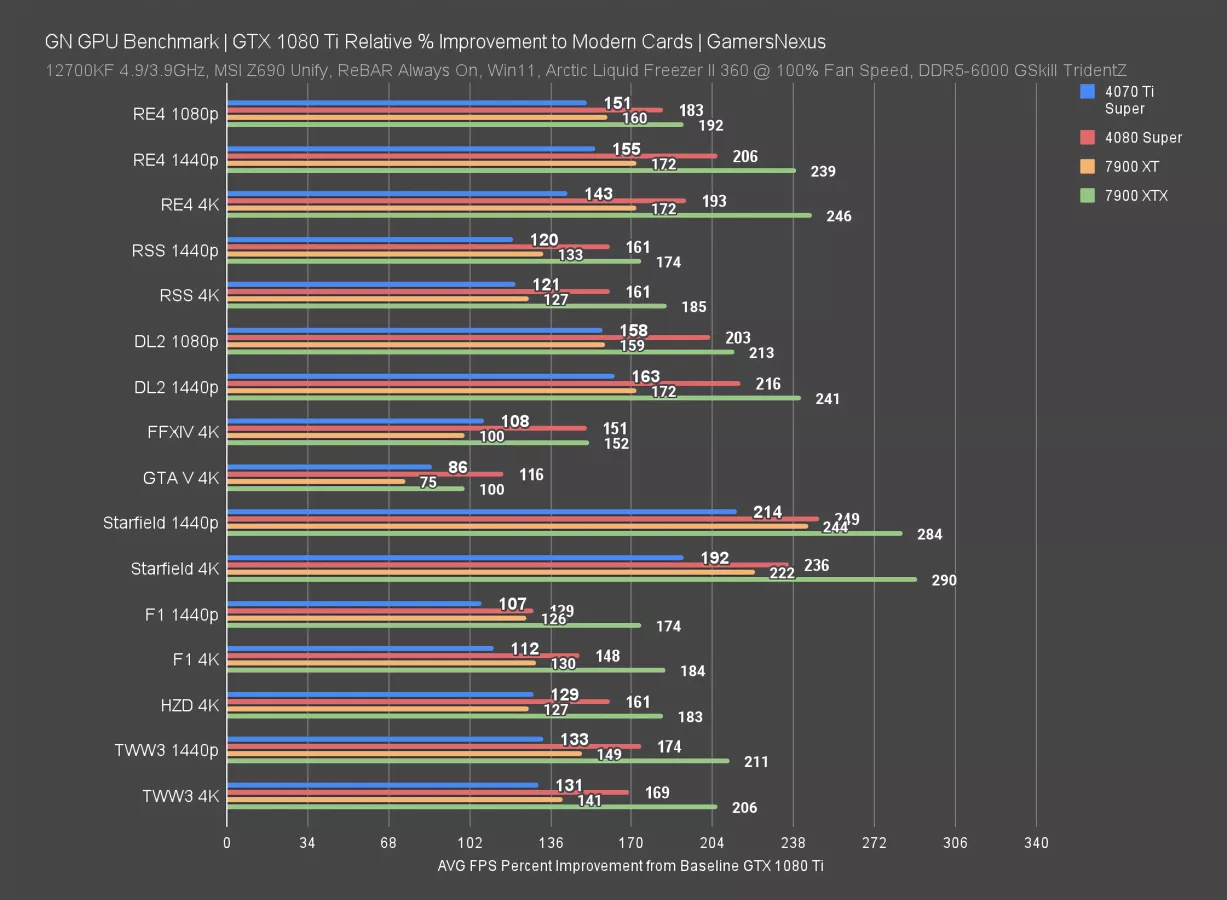
Here it is against a bunch of games. The 1080 Ti itself is not shown. That’s because it’s the left axis, or baseline. We are looking at percent improvement over baseline in average FPS.
This is one of those scenarios where anything would be an upgrade. Generally speaking, you can expect somewhere around a 120-150% uplift with a 4070 Ti Super across these suite of games. The 4080 Super (read our review here), roughly speaking, would give you around 170-190% uplift. The XT is around the 140-160% for uplift, with the XTX at 190-210% or so broadly speaking. Each of these has several break-outs, including the 7900 XTX spiking upwards of 300% improvement in Starfield. At that point, percentages don’t feel like they mean anything anymore. Suffice to say, it’s an entirely different experience. You should basically be choosing between the modern cards that you're considering rather than necessarily comparing them to the 1080 Ti because all of these are going to be massive changes in the experience but it's still fun to look back and get a feel for it this way.
Recap: GTX 1080 vs. 7900 GRE, 7900 XT, 4070 Super, 4070 Ti Super
The next recap is for the GTX 1080. For this one, we’re comparing against the RTX 4070 Super, the RTX 4070 Ti Super, the RX 7900 GRE that just got a global launch, and the RX 7900 XT (read our revisit here). The 4070 Super is the same price that the 1080 launched when ignoring inflation, or would be the equivalent of $470 at launch back then. The 7900 GRE is a similar price today, or including inflation, would be about $431 back at launch. That gives us two cards priced similarly with inflation and two priced below.
Here’s the chart.
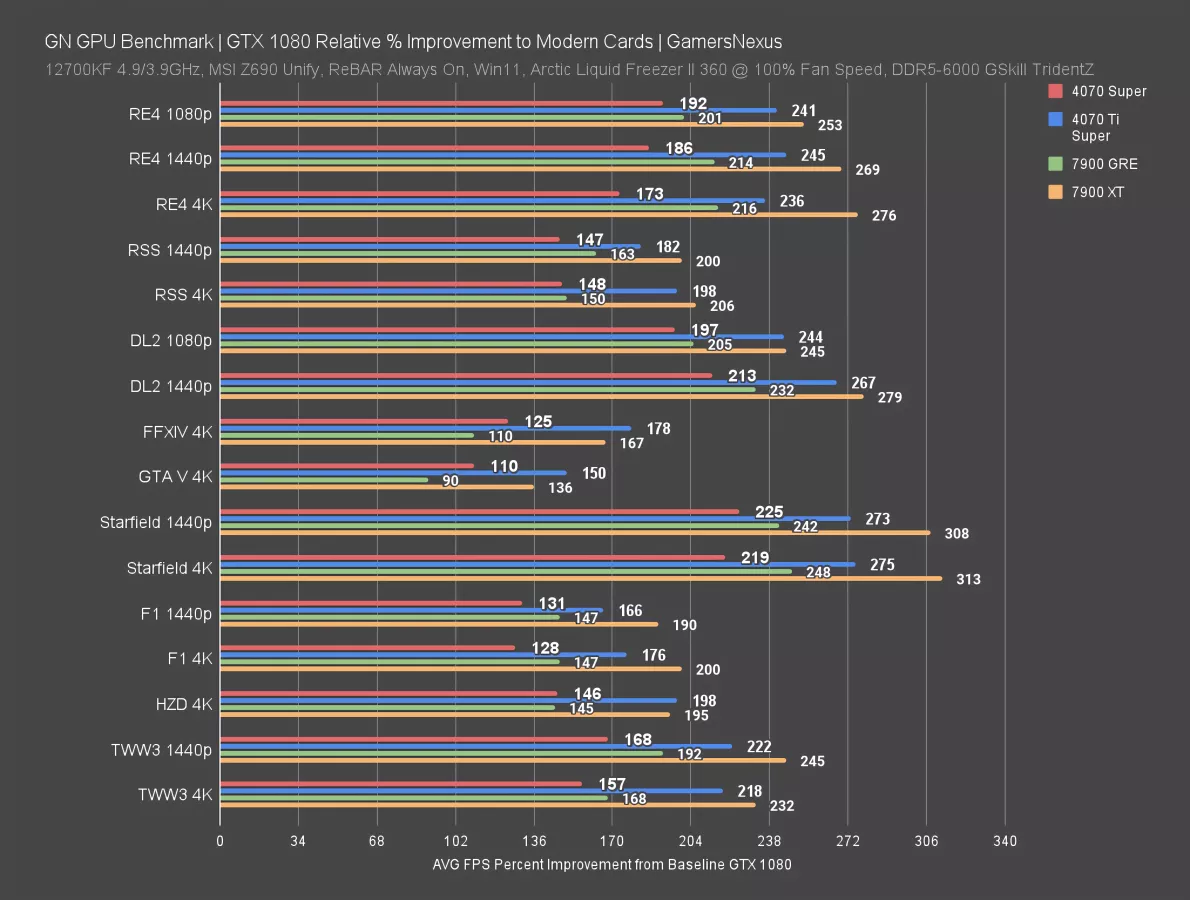
The 1080 Ti doesn’t appear here since we already showed a summary chart for that, but as a reminder, that’d generally be around 35% uplift from the 1080. For the rest, you can get increases in average FPS in the multiples even with something at an equal price today when ignoring inflation. Even if your buying power hasn’t kept up with inflation, you can at least get a 2-3x increase in many scenarios with a 4070 Super (read our review here). The 4070 Ti Super (read our review here) is better enough that it may help pull you forward another year than the 4070 Super, though that depends so much on how much you’re willing to lower graphics settings that it’s hard to make estimates like that. You’re paying for that theoretical longevity. The 7900 GRE also provides significant uplift while being cheaper than $600 and is one of the more relevant cards at that price point right now.
The 7900 XT is just in another class of rasterization performance altogether. It blows these away; the biggest difference though would be in ray tracing.
GTX 1080 Ti Ray Tracing
We're about to get into the individual game test just to give some foundational data with more charts. There aren’t ray tracing charts here because the 1080 Ti does not natively or meaningfully support realtime ray tracing in modern games. Because of that, there's not really anything to test. For ray tracing results, just look at the RT charts in our 7900 GRE review or any other recent GPU review.
GTX 1080 Ti Game Charts
We’ll quickly run through a few game charts. Because we’ve already covered the major comparisons, these will mostly be to focus on key highlights or to provide a wider scope of cards to compare against. There are a lot on here, so feel free to pause at any point for the ones you care about.
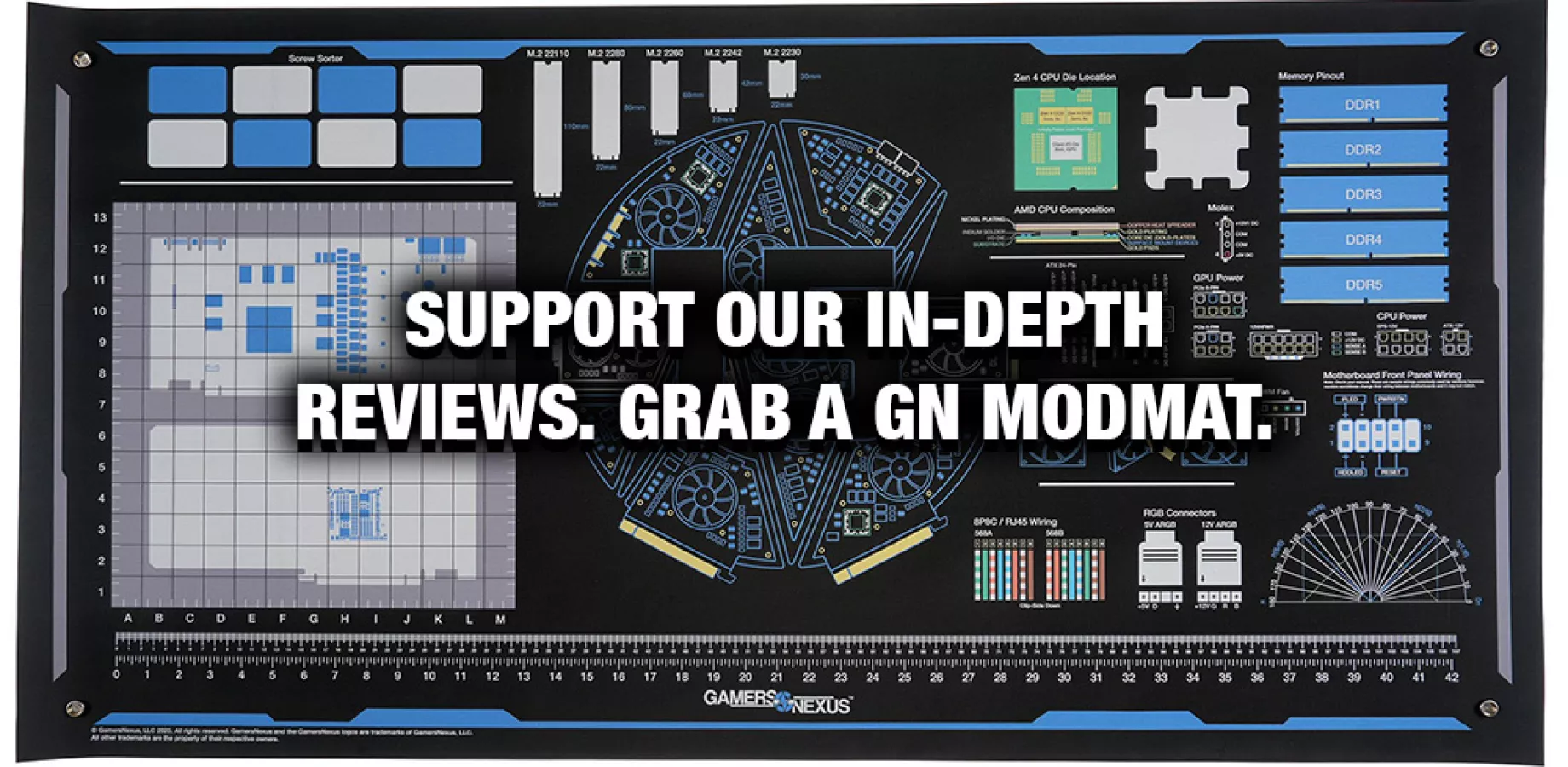
FFXIV - 4K
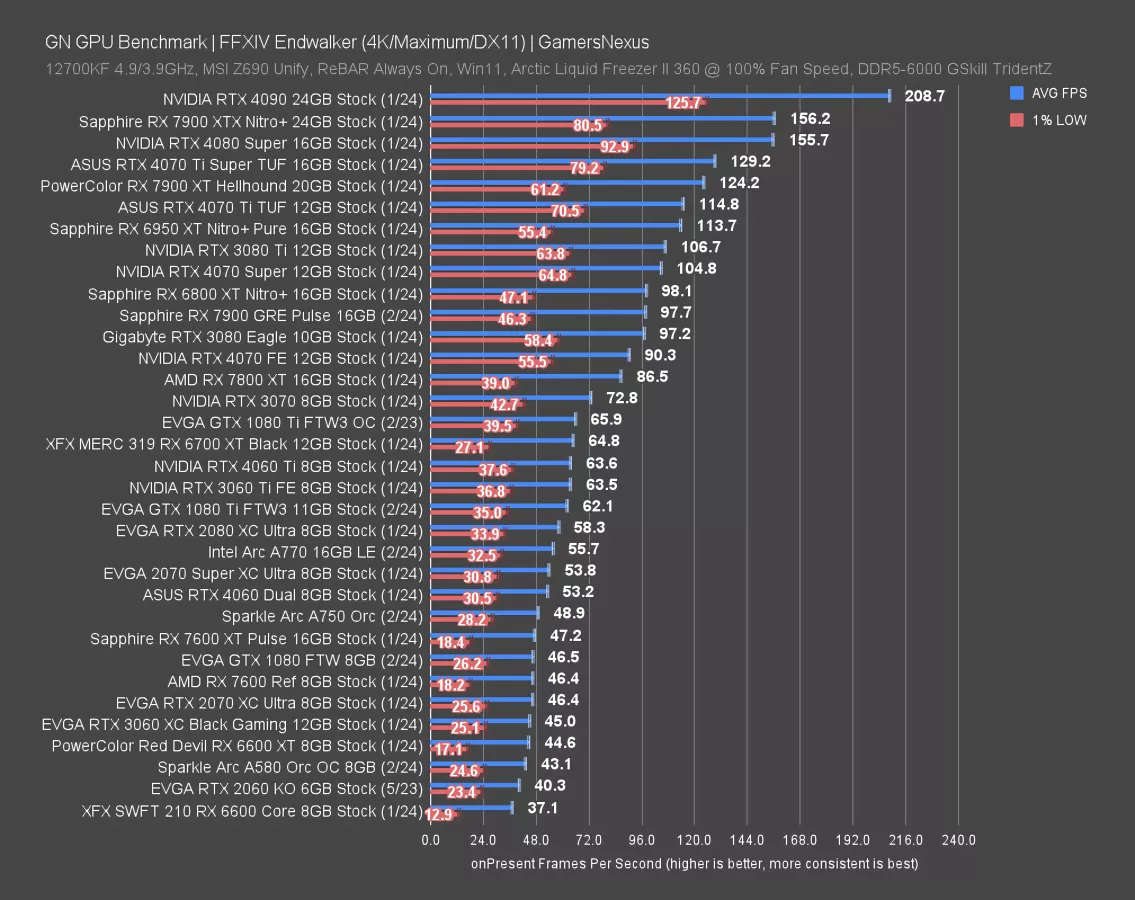
In Final Fantasy 14 at 4K, the GTX 1080 Ti still manages to hold a 62 FPS AVG. No problems here. That has it at 3060 Ti (read our review here) levels of performance and actually surpassing the 2080, somewhat embarrassingly for the Turing card. The 1080 FTW ran at about RX 7600 levels of performance, flanked by the two available models. This chart actually also contains an overclock we ran for the 1080 Ti last year for our revisit (and that data is still valid -- this game’s results don’t change in our test approach). That OC had it up at 6700 XT average FPS, surpassing the 4060 Ti.
Dying Light 2 - 1080p

In Dying Light 2 at 1080p, the GTX 1080 sat below the RX 6600 in our most recent round of testing. The 3060 also leads it somewhat significantly. The 1080 Ti has done excellently to hang-on here, but in some heavier modern games, it is beginning to fall to the bottom of the charts. Of note, even Intel’s A750 is outdoing the 1080 Ti in this one. The RTX 3080 is a good reference point, at 151 FPS average to the 1080 Ti’s 74, or the 1080’s 55.
One last note: You can see the 1% lows dip down on the 1080, indicative of where some of the generational improvements have been invested over the years.
Dying Light 2 - 1440p
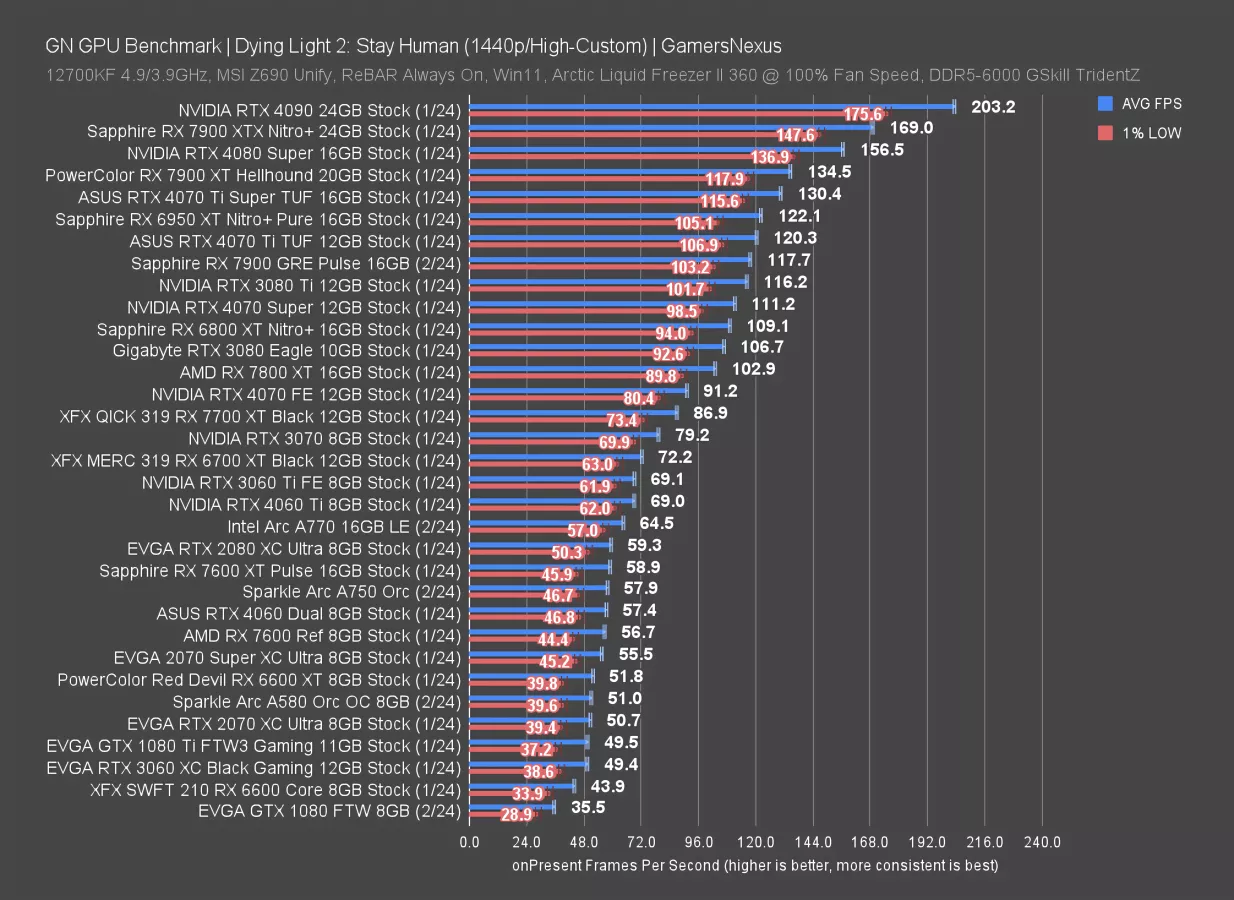
1440p stretches the scale to the point that the 1080 Ti now falls below 60 FPS. If we choose 60 FPS as a somewhat arbitrary line of scrimmage, the first card that passes it is the A770 on this chart, with the 7600 XT and 2080 close enough. For non-Intel, you might consider the 4070 or 7800 XT as meaningfully improved over the 1080 Ti, but probably with less staying power than you benefited from on the 1080 Ti.
Starfield 1440p
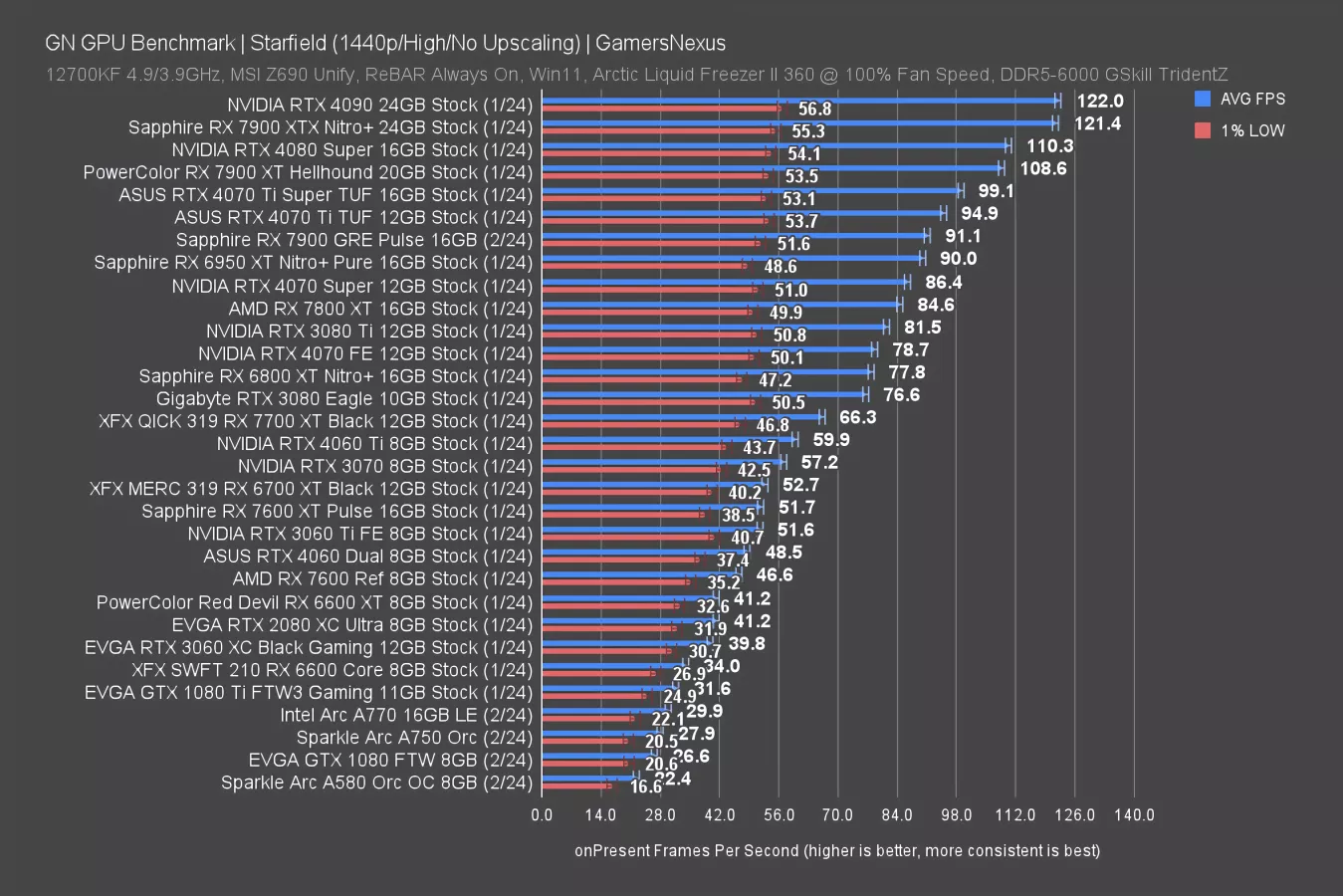
We tested Starfield at 1440p mostly because it helps us avoid non-GPU limitations higher up the stack, the GTX 1080’s performance had it about tied with an Intel A750 GPU. Intel struggles in Starfield, so it’s not the best comparison. The RX 6600 (watch our review here) and RTX 3060 both post large gains over the 1080, despite neither being a recommended path forward from the card. This and the 1080 Ti alike would be hugely improved upon by nearly anything in the chart. 1440p is heavy with this game on these cards. They were capable 1440p players at the time, and even some 4K, but games have also gotten heavier in the years since Pascal.
Starfield - 4K
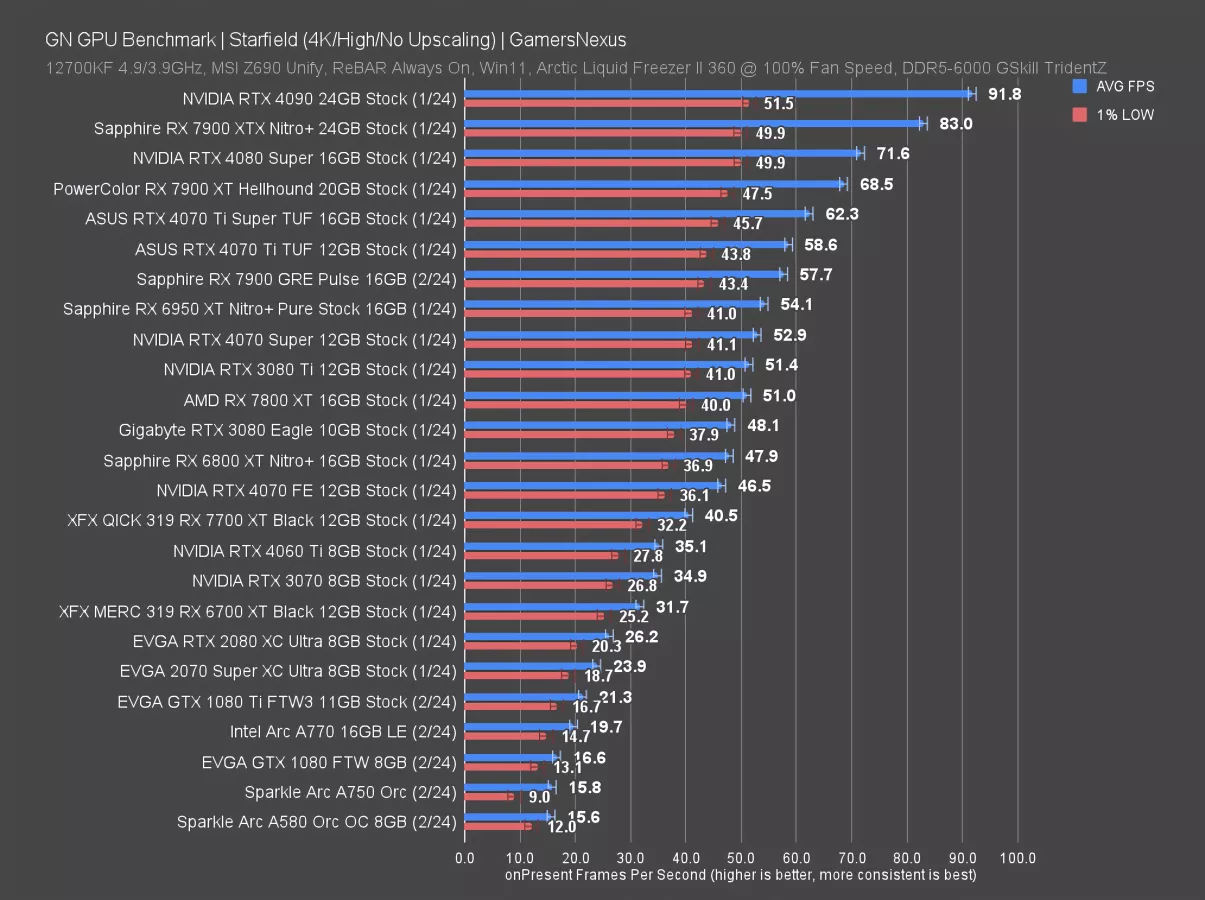
At 4K, the Pascal cards can’t handle the game and are clearly struggling. Their results are less consistent as a result of the load. To get to a meaningful uplift might mean a jump to a 7800 XT, a used RTX 3080 as a great option, or the 4070 Super.
Rainbow Six Siege 1080p
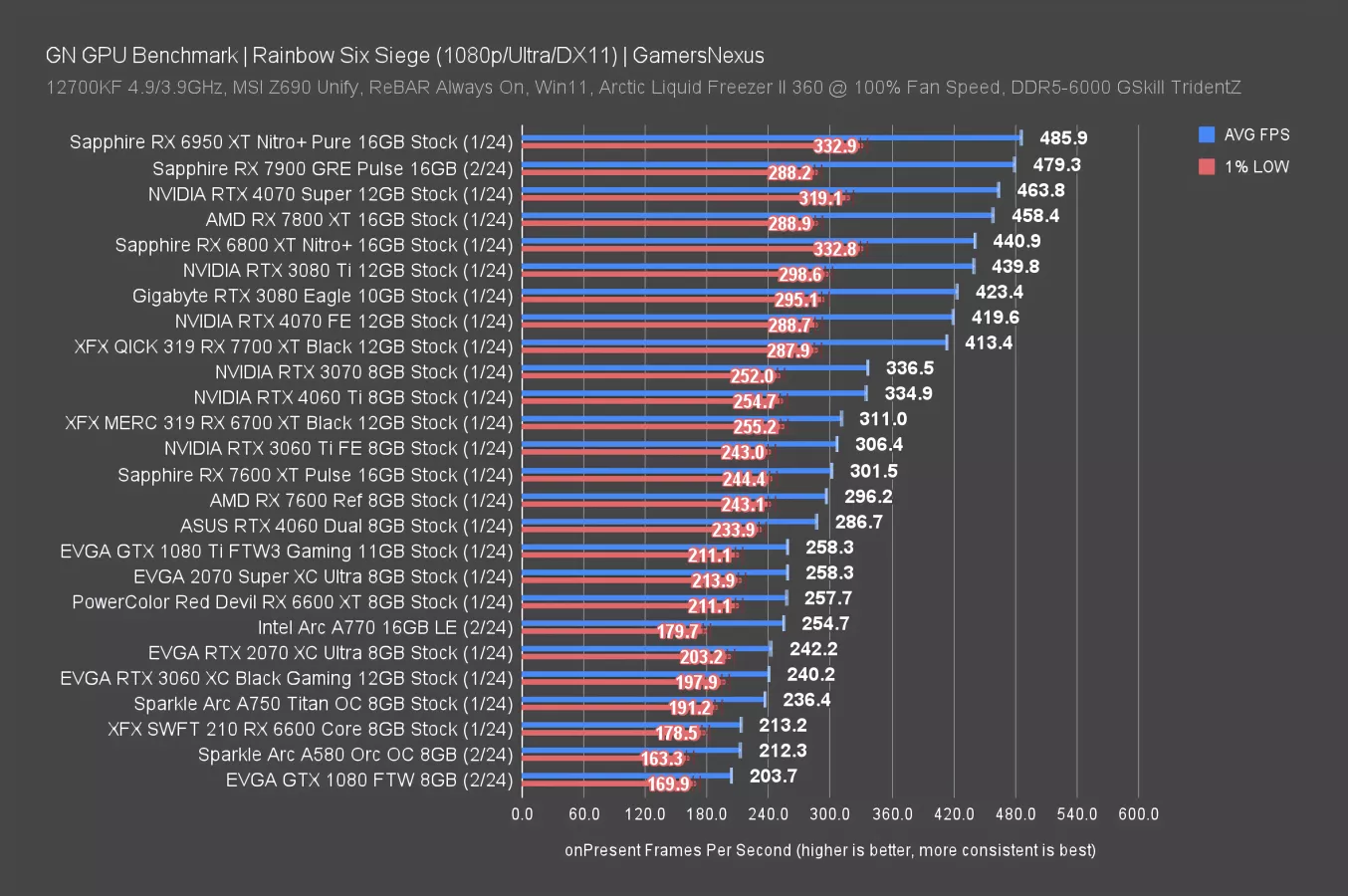
In Rainbow Six Siege at 1080p, we’re served a reminder that both of these cards can still be objectively capable performers for the right title. This combination of resolution and game still puts the GOAT 1080 Ti into the hundreds of FPS, approaching 300 for the average, with even its slower 1080 counterpart still surpassing 200 FPS AVG. If you’re not playing the heaviest games at higher resolutions and if you don’t always need max settings, then in an objective sense, these are still good enough. Anyone ultra competitive might notice a latency difference between the 1080 Ti and a 4070 Super here, but generally speaking, if you’re not noticing the performance of your 10-series card as being bad, there’s no shame in sticking with it. To us, it’s a sense of pride. That’s why Steve still has a GTX 1080 Ti in his home machine.
Rainbow Six Siege 1440p
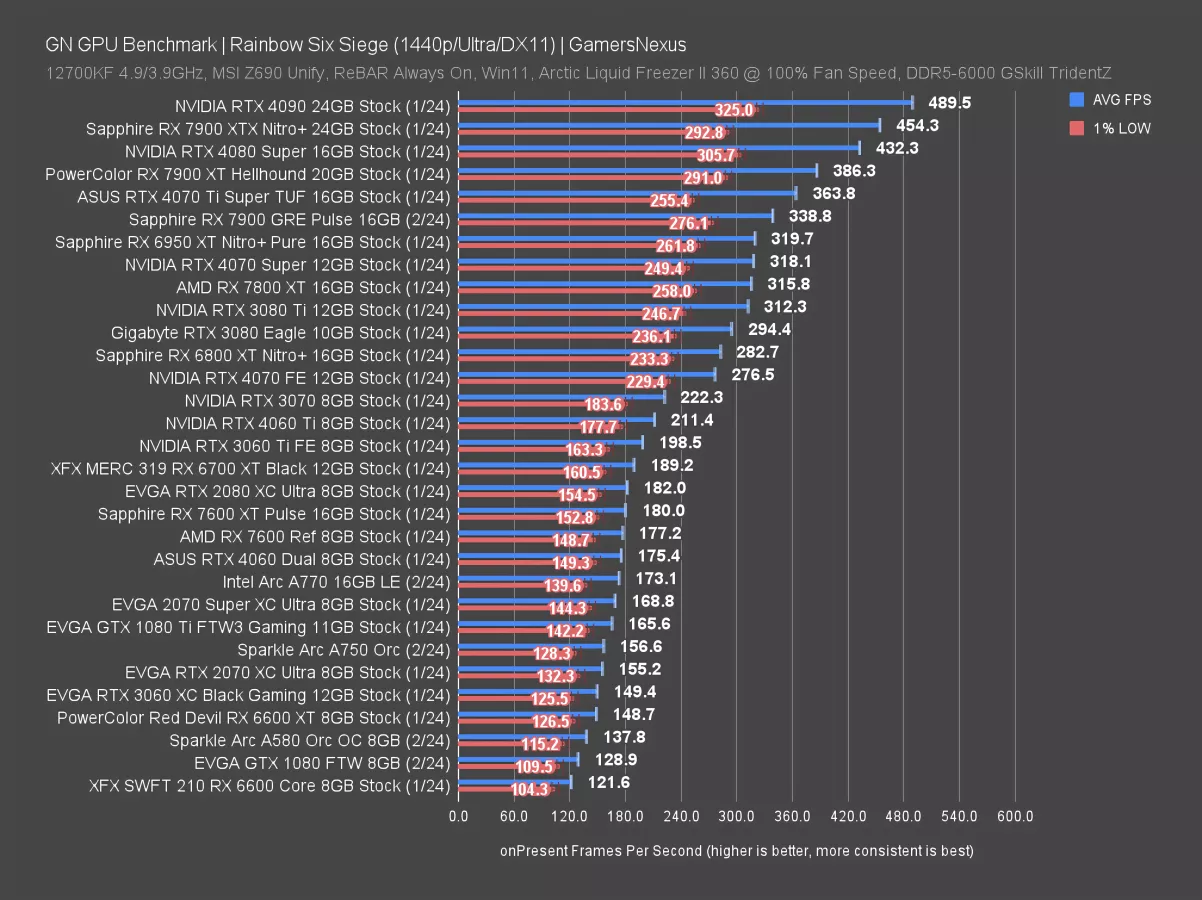
At 1440p, the GTX 1080 still holds 130 FPS AVG in Rainbow Six Siege, with the GTX 1080 Ti continuing to impress and earn its GOAT title, all 7 years later, with a performance equivalent to the 2070 Super and besting the modern A750 (read our revisit here). Noteworthy entries on this one remain the RTX 3080, which would still give a huge upgrade pathway while potentially running cheap if you’re willing to trust a used listing. The new RX 7900 GRE also jaunts ahead for something at a balanced price.
Rainbow Six Siege - 4K
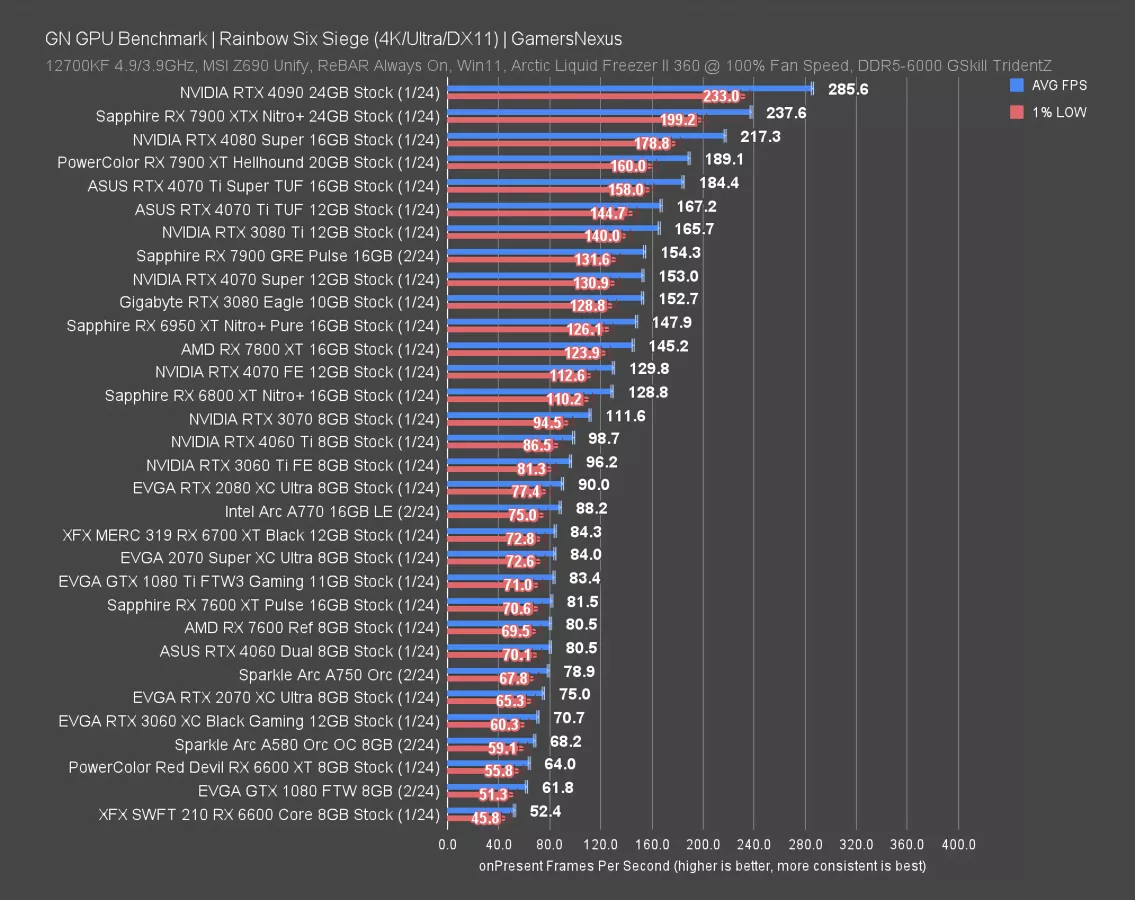
At 4K, the Pascal cards both manage to keep their framerate above 60 FPS: The 1080 Ti FTW3 held an impressive 83, tying it with the 2070 Super and 7600 XT, and the 1080 FTW ran at 62, about the same as the 6600 XT. They’re still hanging in there. Another option we haven’t discussed is a potential used 3070 (watch our review here), but it’d really have to be cheap enough to be worthwhile. Other cards probably feel a lot better to move to than a 3070 if you’re a current 1080 or 1080 Ti owner, if only from the psychological association with the name. If you can get a 6950 XT (watch our review here) for $500 or so, that’s one that people are probably sleeping on these days.
Resident Evil 4 - 1080p
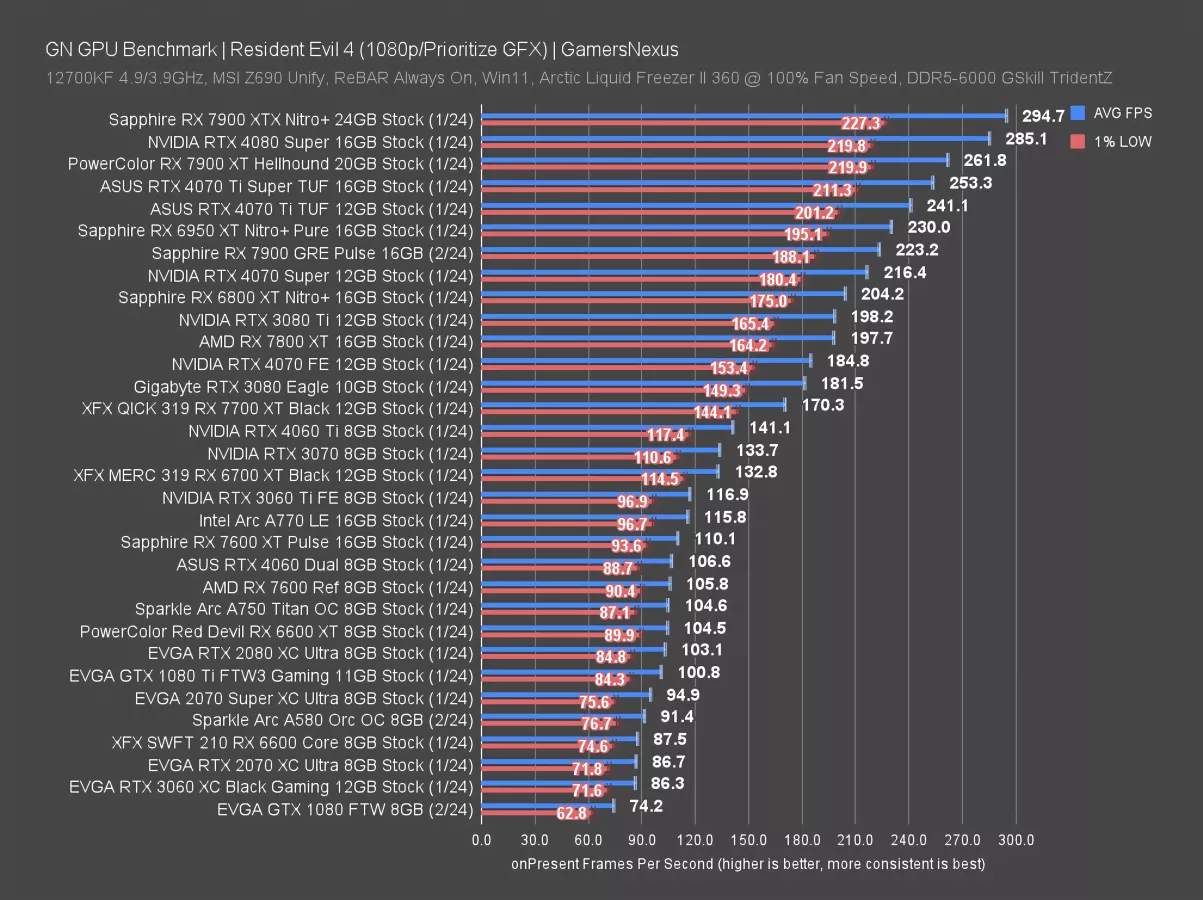
Resident Evil 4 at 1080p is up now, another of the relatively new titles in the suite. This one has the 1080 Ti at 101 FPS AVG and the 1080 at 74. That’s not bad. The 1080 Ti puts up a performance not distant from the RTX 2080 and just ahead of the 2070 Super. The 1080 trails the 3060. This is still playable on both.
Resident Evil 4 - 1440p
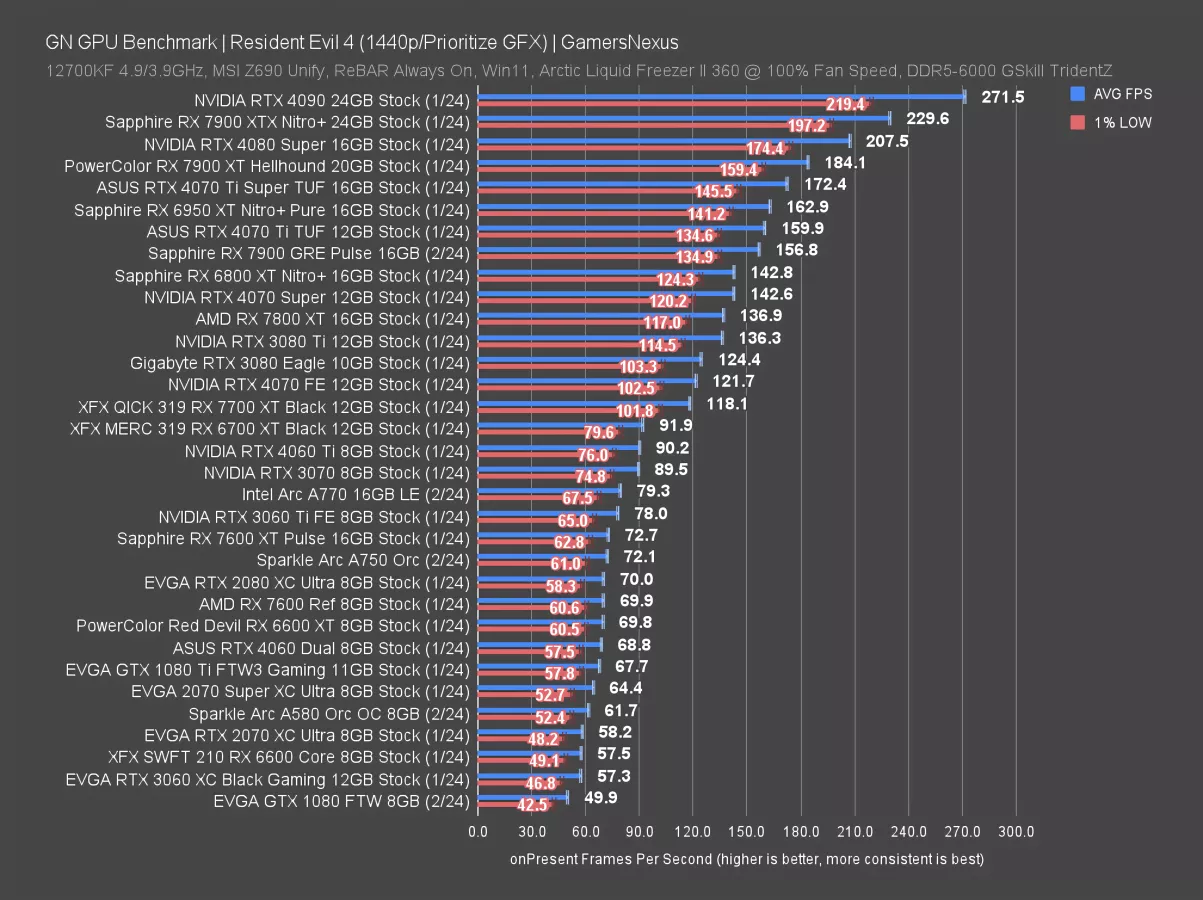
At 1440p, the 1080 FTW slips to about 50 FPS AVG. Still playable, but less enjoyably. The 1080 Ti maintains an overall good framerate and is effectively tied with the RTX 4060. You’d want to buy into a higher class of card if upgrading, otherwise it’ll just be the same in rasterization except with RT support for less intensive RT titles. On the AMD side, the 6950 XT remains worth paying attention to in the used market, as does the RTX 3080 for used. For new cards, the 7900 XT remains hard to beat for value with its $700 to $720 pricing lately. And for NVIDIA, the 4070 Super might be one of the stronger modern values.
Resident Evil 4 - 4K

At 4K, both cards struggle. They fall off more as resolution increases in modern titles. The 1080 Ti manages to hang onto the 2080 equivalence, reminding us of exactly why our RTX 2080 launch-day review conclusion was to just go buy a 1080 Ti. Remember, at that time, there were literally 0 RTX games. The first RTX game wouldn’t launch for another 2 months, and because we’re not in the business of reviewing promises, the 1080 Ti made way more sense. It was comparatively cheap back then. It’s incredible how many generations this card has managed to survive, and matching the 2080 really proves that.
GTA V - 4K
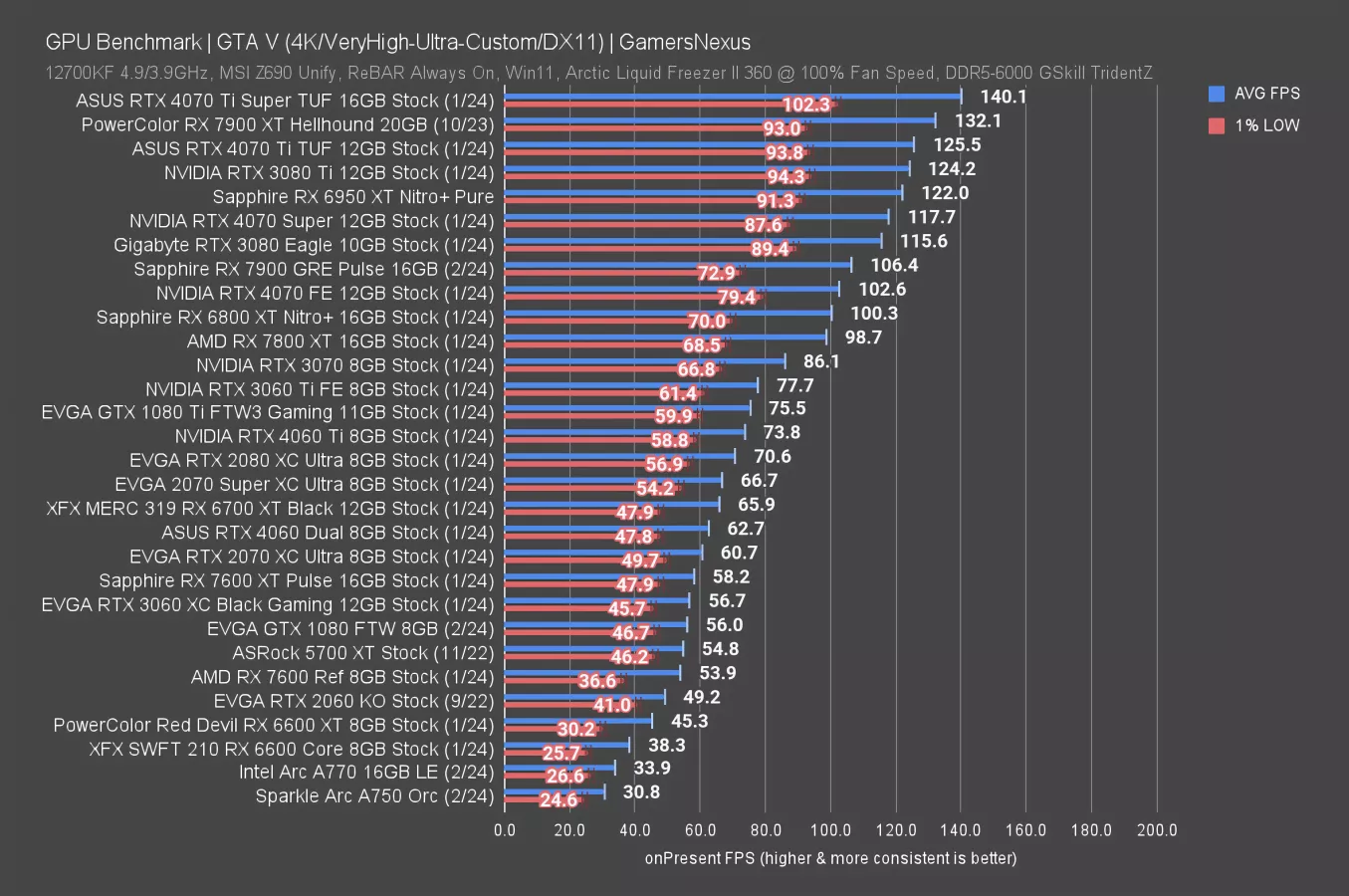
Finally, in GTA V, the 1080 held a 56 FPS AVG and was between the 5700 XT (watch our review here) and 3060 at 4K. The 1080 Ti continues to impress and outmatches the 4060 Ti. It’s a hell of a show from Pascal.
GTX 1080 Ti Power Consumption
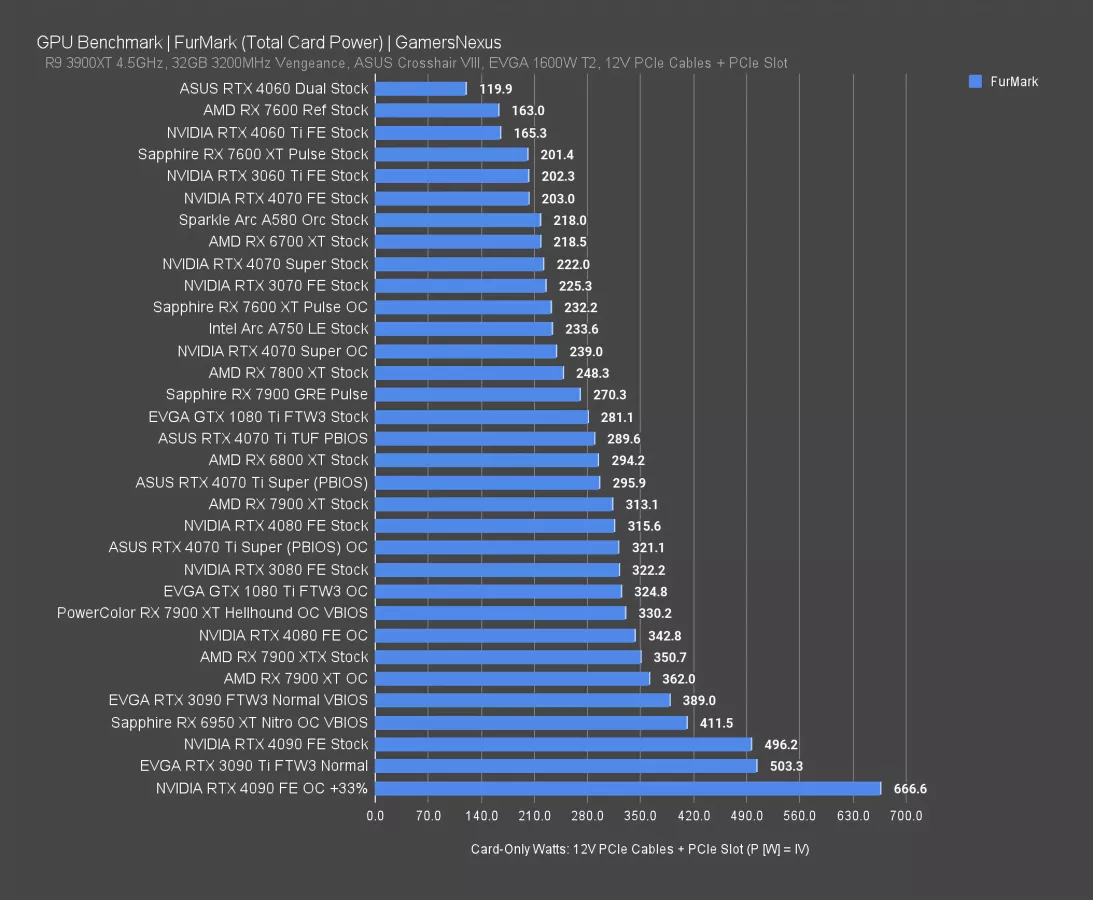
Finally, just for fun, here’s some power consumption numbers. In a total 100% workload, we had the 1080 Ti at about 283W. That has it more power hungry than the 7900 GRE, so if nothing else, cards have definitely gotten way more efficient over the years in terms of FPS. It’s similar to the 4070 Ti non-Super.
With an overclock, we had the 1080 Ti at 325W. That’s another aspect that GOATed the card: Its OC headroom was often enormous, with board partners more enabled to expand the total power budget than you’ll often find today. This has it around the 7900 XT and 3080.
GTX 1080 Ti Conclusion

To recap some of the pricing, the 4070 Super is similar in price if you ignore inflation. It's cheaper if you factor it in, at around $470. The 4070 Ti Super is the same price back then with inflation, meaning if you spent that amount of money today and then you got in a time machine and went back, you'd be buying a 1080 Ti with roughly the same money. The 7900 GRE is cheaper when you ignore inflation. It would be about $431 in 2016 while the 7900 XT is similar price with inflation now.
These inflation numbers come from US Government data. For the numbers, we compared the precise launch date for the 1080 Ti against December of 2023 as they didn't have 2024 data available yet. Those are kind of the numbers to consider ultimately if you feel like your buying power is about the same as it was back in that era then you're looking at something like maybe the 4070 Ti, 7900 XT, or something in that range.
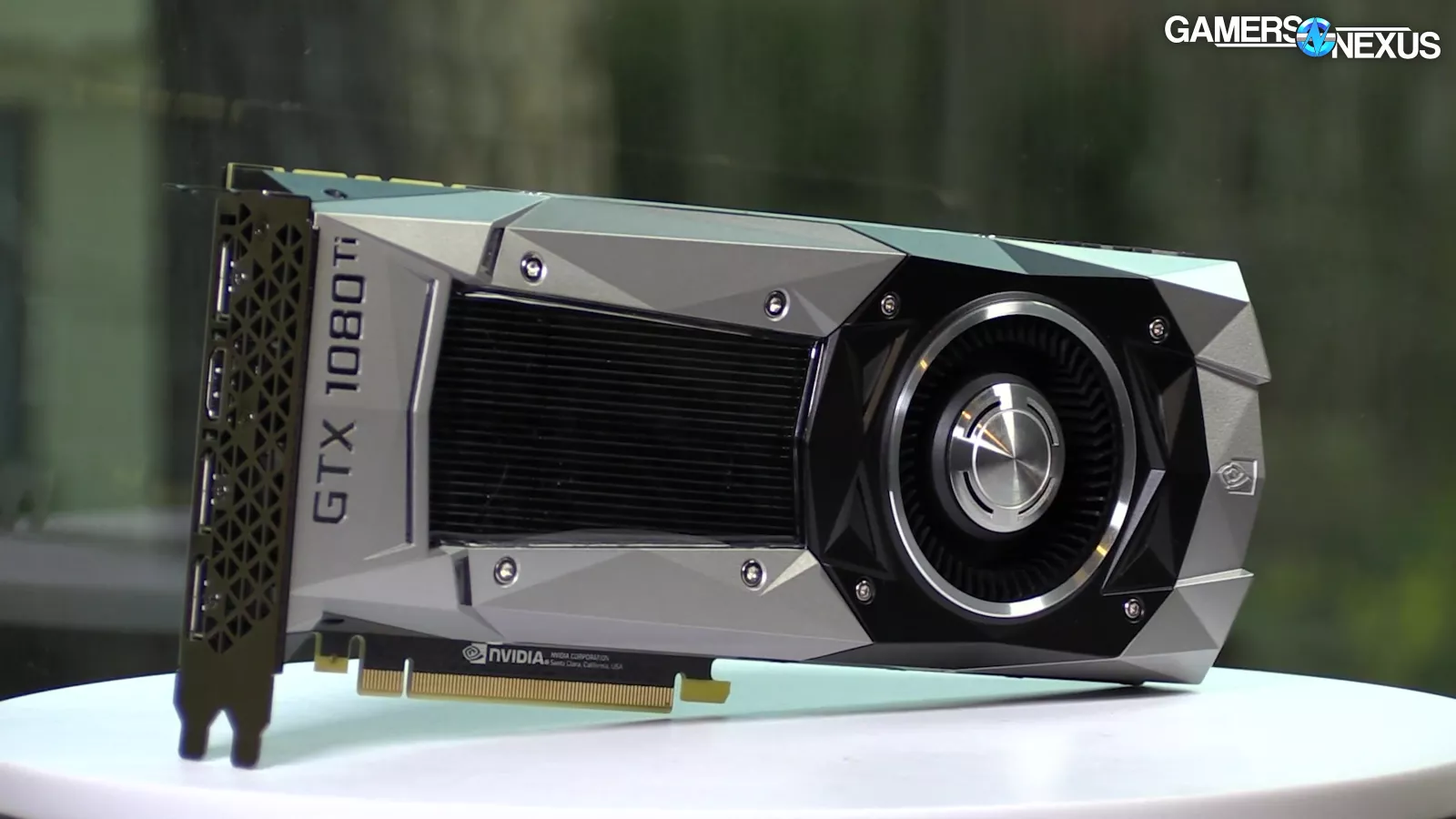
The 1080 Ti holds on to its crown as the GOAT and at this point, it's not going to let go of it. The card will go down as completely legendary when it eventually gets retired from our benches but until we can't really run things anymore, we're going to keep it in as many charts as we can because it's just fun to see how well it's holding up.
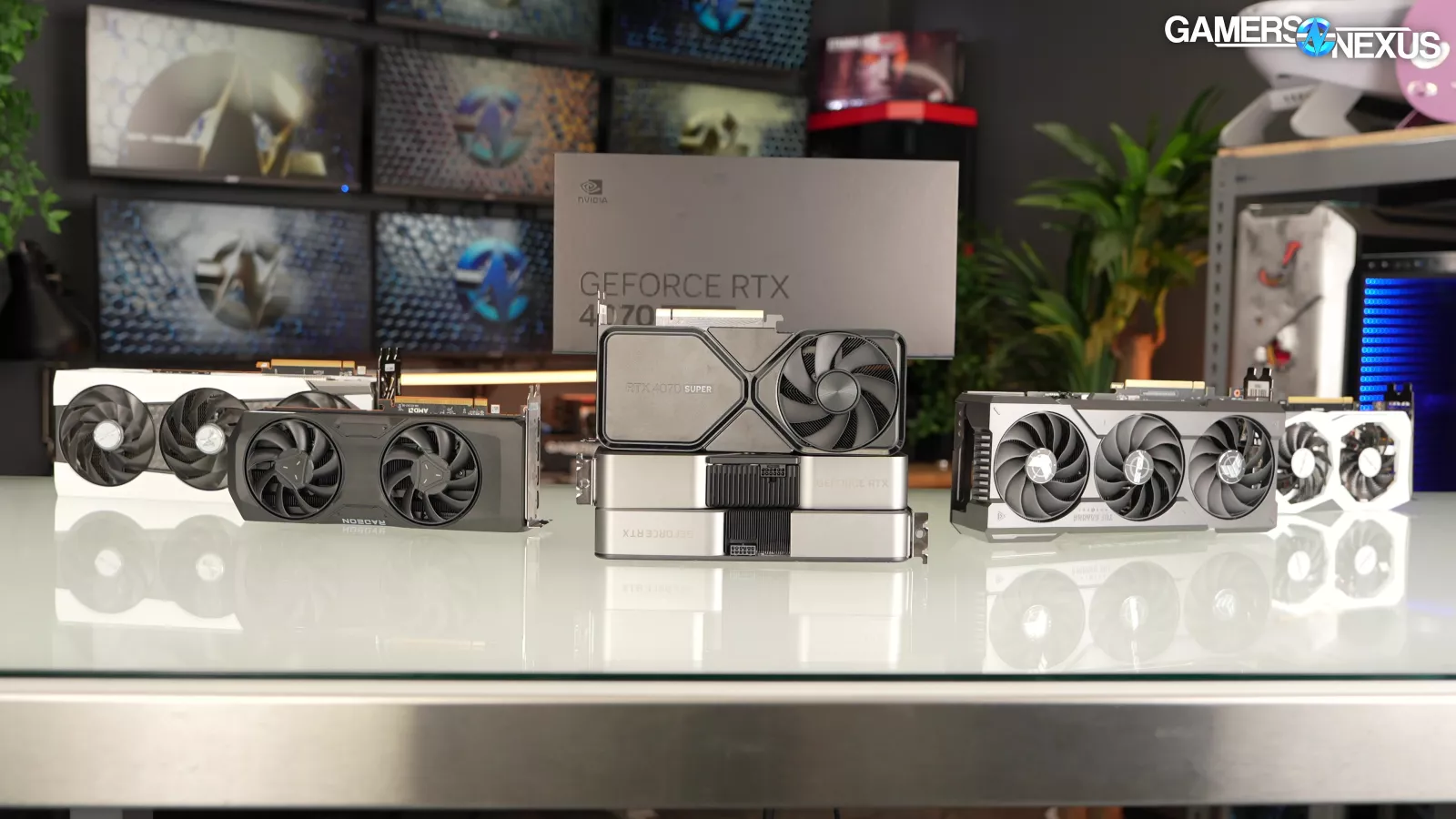
If you're looking to buy something new, viable options include the 4070 Ti Super and 7900 XT. The 7900 XTX has also come down in price to $900 to $950 these days. In the used space, the 6950 XT and the 3080 are starting points. The 4070 Super is also a more affordable option that will still provide a meaningful uplift along with some ray tracing.
If you're looking for the next 1080 Ti, there doesn't really seem to be one right now. The 3080 was lined up for it but couldn't quite take that title. The 4090 is definitely the closest contender but its price just takes away a lot of the power that it would have in terms of that association. It's got to be a combination of the two together that make something as special as the 1080 Ti was, which still plays games if you're not into RT or don't care yet. If you can get by on either older titles or playing at 1080p and don’t feel like the card is underperforming, then perhaps you don’t need to upgrade or can just wait until the next generation.
